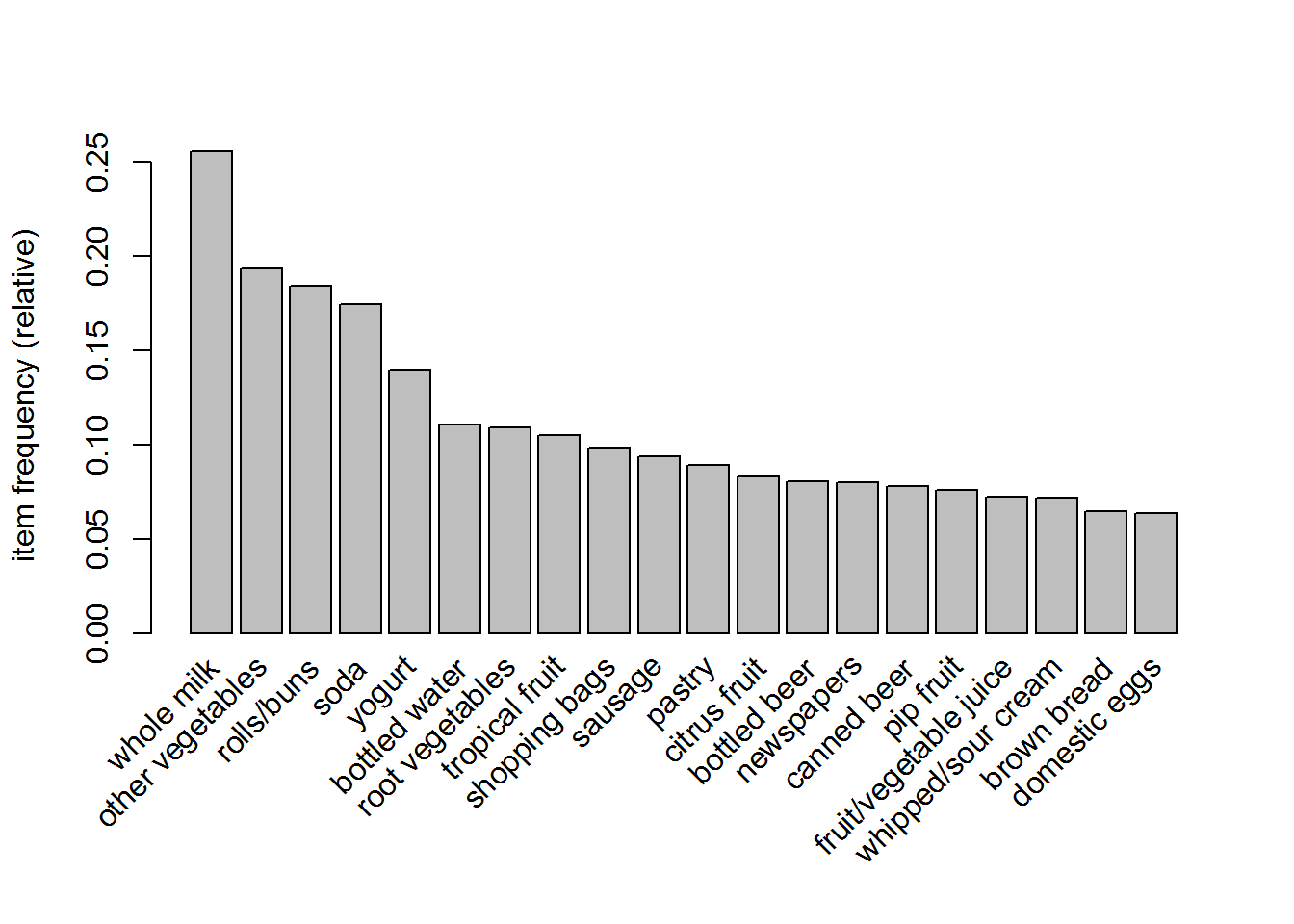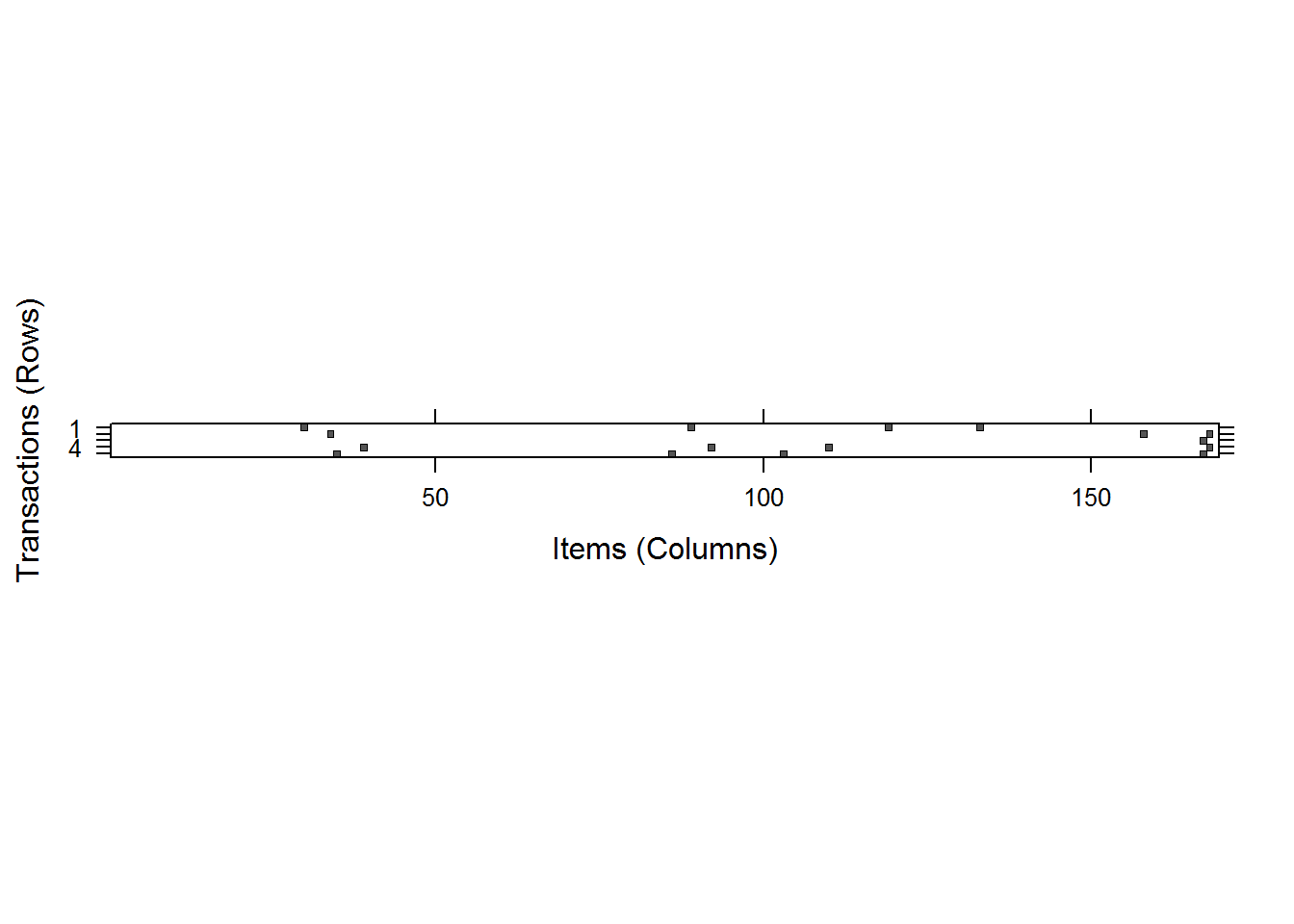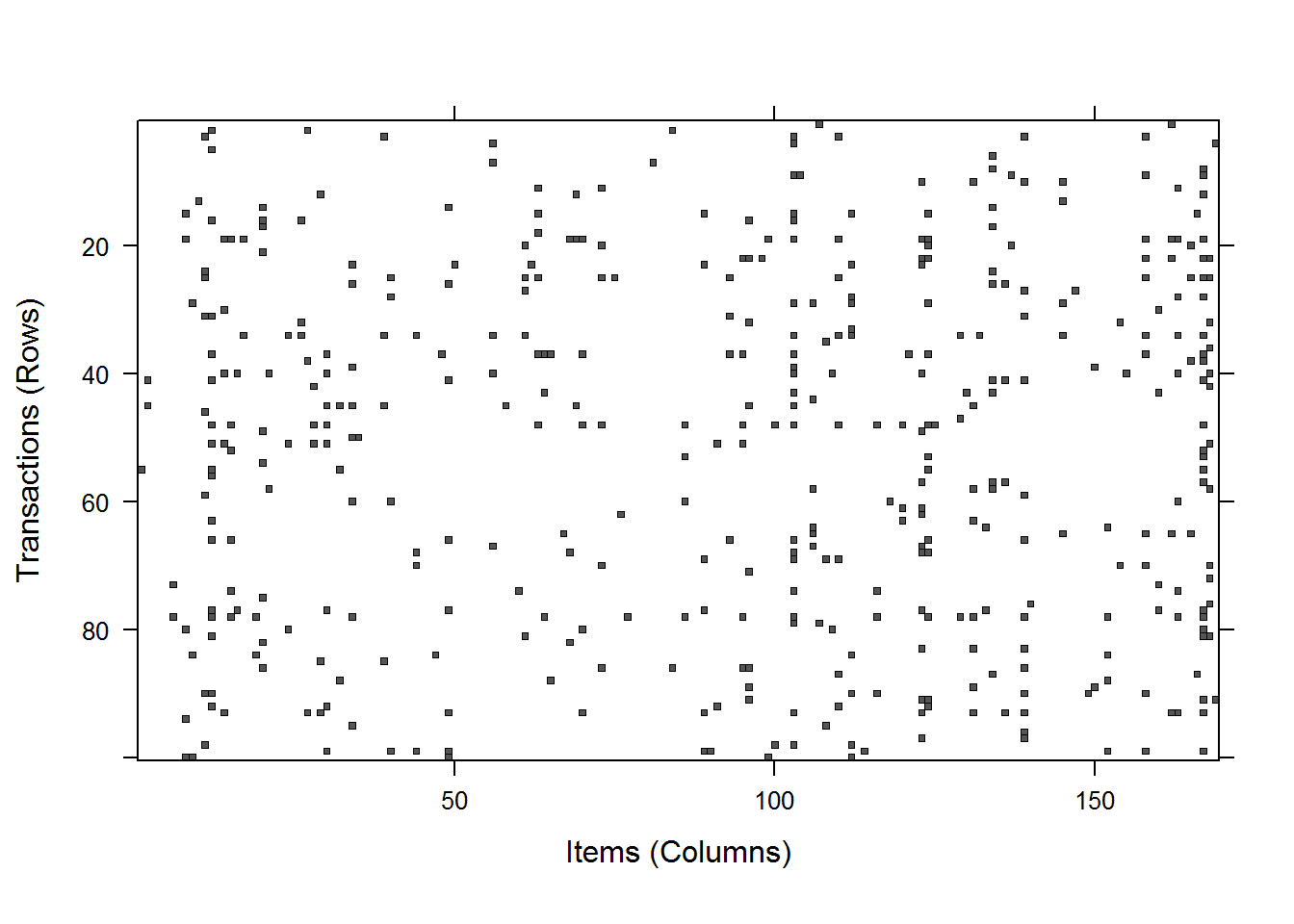Association Rules-identifying frequently purchased groceries with association rules. market basket analysis will utilize the purchase data collected from one month of operation at a real-world grocery store. The data contains 9,835 transactions or about 327 transactions per day (roughly 30 transactions per hour in a 12-hour business day), suggesting that the retailer is not particularly large, nor is it particularly small.
The typical grocery store offers a huge variety of items. There might be five brands of milk, a dozen different types of laundry detergent, and three brands of coffee. Given the moderate size of the retailer, we will assume that they are not terribly concerned with finding rules that apply only to a specific brand of milk or detergent. With this in mind, all brand names can be removed from the purchases. This reduces the number of groceries to a more manageable 169 types, using broad categories such as chicken, frozen meals, margarine, and soda.
Since we’re loading the transactional data, we cannot simply use the read.csv() function used previously. Instead, arules provides a read.transactions() function that is similar to read.csv() with the exception that it results in a sparse matrix suitable for transactional data. The sep = “,” parameter specifies that items in the input file are separated by a comma. To read the groceries.csv data into a sparse matrix named groceries, type the following line:
##### Chapter 8: Association Rules
## Example: Identifying Frequently-Purchased Groceries
## Step 2: Exploring and preparing the data
# load the grocery data into a sparse matrix
library(arules)## Warning: package 'arules' was built under R version 3.3.3## Loading required package: Matrix##
## Attaching package: 'arules'## The following objects are masked from 'package:base':
##
## abbreviate, writegroceries <- read.transactions("C:/Users/Bhawna/Documents/blog/data/groceries.csv", sep = ",")
summary(groceries)## transactions as itemMatrix in sparse format with
## 9835 rows (elements/itemsets/transactions) and
## 169 columns (items) and a density of 0.02609146
##
## most frequent items:
## whole milk other vegetables rolls/buns soda
## 2513 1903 1809 1715
## yogurt (Other)
## 1372 34055
##
## element (itemset/transaction) length distribution:
## sizes
## 1 2 3 4 5 6 7 8 9 10 11 12 13 14 15
## 2159 1643 1299 1005 855 645 545 438 350 246 182 117 78 77 55
## 16 17 18 19 20 21 22 23 24 26 27 28 29 32
## 46 29 14 14 9 11 4 6 1 1 1 1 3 1
##
## Min. 1st Qu. Median Mean 3rd Qu. Max.
## 1.000 2.000 3.000 4.409 6.000 32.000
##
## includes extended item information - examples:
## labels
## 1 abrasive cleaner
## 2 artif. sweetener
## 3 baby cosmetics# look at the first five transactions
inspect(groceries[1:5])## items
## [1] {citrus fruit,
## margarine,
## ready soups,
## semi-finished bread}
## [2] {coffee,
## tropical fruit,
## yogurt}
## [3] {whole milk}
## [4] {cream cheese,
## meat spreads,
## pip fruit,
## yogurt}
## [5] {condensed milk,
## long life bakery product,
## other vegetables,
## whole milk}# examine the frequency of items
itemFrequency(groceries[, 1:3])## abrasive cleaner artif. sweetener baby cosmetics
## 0.0035587189 0.0032536858 0.0006100661# plot the frequency of items
itemFrequencyPlot(groceries, support = 0.1)
itemFrequencyPlot(groceries, topN = 20)
# a visualization of the sparse matrix for the first five transactions
image(groceries[1:5])
# visualization of a random sample of 100 transactions
image(sample(groceries, 100))
## Step 3: Training a model on the data
library(arules)
# default settings result in zero rules learned
apriori(groceries)## Apriori
##
## Parameter specification:
## confidence minval smax arem aval originalSupport maxtime support minlen
## 0.8 0.1 1 none FALSE TRUE 5 0.1 1
## maxlen target ext
## 10 rules FALSE
##
## Algorithmic control:
## filter tree heap memopt load sort verbose
## 0.1 TRUE TRUE FALSE TRUE 2 TRUE
##
## Absolute minimum support count: 983
##
## set item appearances ...[0 item(s)] done [0.00s].
## set transactions ...[169 item(s), 9835 transaction(s)] done [0.00s].
## sorting and recoding items ... [8 item(s)] done [0.00s].
## creating transaction tree ... done [0.00s].
## checking subsets of size 1 2 done [0.00s].
## writing ... [0 rule(s)] done [0.00s].
## creating S4 object ... done [0.00s].## set of 0 rules# set better support and confidence levels to learn more rules
groceryrules <- apriori(groceries, parameter = list(support =
0.006, confidence = 0.25, minlen = 2))## Apriori
##
## Parameter specification:
## confidence minval smax arem aval originalSupport maxtime support minlen
## 0.25 0.1 1 none FALSE TRUE 5 0.006 2
## maxlen target ext
## 10 rules FALSE
##
## Algorithmic control:
## filter tree heap memopt load sort verbose
## 0.1 TRUE TRUE FALSE TRUE 2 TRUE
##
## Absolute minimum support count: 59
##
## set item appearances ...[0 item(s)] done [0.00s].
## set transactions ...[169 item(s), 9835 transaction(s)] done [0.00s].
## sorting and recoding items ... [109 item(s)] done [0.00s].
## creating transaction tree ... done [0.00s].
## checking subsets of size 1 2 3 4 done [0.02s].
## writing ... [463 rule(s)] done [0.00s].
## creating S4 object ... done [0.00s].groceryrules## set of 463 rules## Step 4: Evaluating model performance
# summary of grocery association rules
summary(groceryrules)## set of 463 rules
##
## rule length distribution (lhs + rhs):sizes
## 2 3 4
## 150 297 16
##
## Min. 1st Qu. Median Mean 3rd Qu. Max.
## 2.000 2.000 3.000 2.711 3.000 4.000
##
## summary of quality measures:
## support confidence lift
## Min. :0.006101 Min. :0.2500 Min. :0.9932
## 1st Qu.:0.007117 1st Qu.:0.2971 1st Qu.:1.6229
## Median :0.008744 Median :0.3554 Median :1.9332
## Mean :0.011539 Mean :0.3786 Mean :2.0351
## 3rd Qu.:0.012303 3rd Qu.:0.4495 3rd Qu.:2.3565
## Max. :0.074835 Max. :0.6600 Max. :3.9565
##
## mining info:
## data ntransactions support confidence
## groceries 9835 0.006 0.25# look at the first three rules
inspect(groceryrules[1:3])## lhs rhs support confidence lift
## [1] {potted plants} => {whole milk} 0.006914082 0.4000000 1.565460
## [2] {pasta} => {whole milk} 0.006100661 0.4054054 1.586614
## [3] {herbs} => {root vegetables} 0.007015760 0.4312500 3.956477## Step 5: Improving model performance
# sorting grocery rules by lift
inspect(sort(groceryrules, by = "lift")[1:5])## lhs rhs support confidence lift
## [1] {herbs} => {root vegetables} 0.007015760 0.4312500 3.956477
## [2] {berries} => {whipped/sour cream} 0.009049314 0.2721713 3.796886
## [3] {other vegetables,
## tropical fruit,
## whole milk} => {root vegetables} 0.007015760 0.4107143 3.768074
## [4] {beef,
## other vegetables} => {root vegetables} 0.007930859 0.4020619 3.688692
## [5] {other vegetables,
## tropical fruit} => {pip fruit} 0.009456024 0.2634561 3.482649# finding subsets of rules containing any berry items
berryrules <- subset(groceryrules, items %in% "berries")
inspect(berryrules)## lhs rhs support confidence lift
## [1] {berries} => {whipped/sour cream} 0.009049314 0.2721713 3.796886
## [2] {berries} => {yogurt} 0.010574479 0.3180428 2.279848
## [3] {berries} => {other vegetables} 0.010269446 0.3088685 1.596280
## [4] {berries} => {whole milk} 0.011794611 0.3547401 1.388328Summary
Association rules are frequently used to find provide useful insights in the massive transaction databases of large retailers. The Apriori algorithm, which we studied in this chapter, does so by setting minimum thresholds of uniqueness, and reporting only the associations meeting these criteria.
Reference: Machine Learning with R - Second Edition - Jul 31, 2015 by Brett Lantz

Share this post
Twitter
Google+
Facebook
Reddit
LinkedIn
StumbleUpon
Email